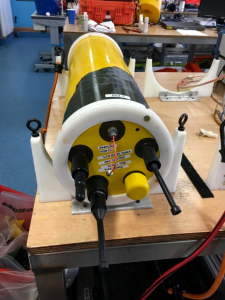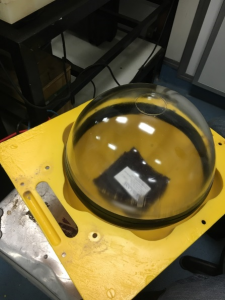Until this cruise, my experience with seismology fieldwork had been entirely on land. The group at Bristol has deployed seismometers in some of the harshest conditions on Earth, including the Canadian Arctic and the Afar region of Ethiopia and Eritrea. Operating a seismometer at the bottom of the ocean presents a whole new set of challenges. Ocean bottom seismology goes back to early work by Maurice Ewing in the late 1930’s, but it was not until the era of nuclear test ban monitoring that the incentive for ocean bottom seismology really picked up – forensic seismology is one of our best methods for monitoring such activities. The lack of seismic monitoring stations on 70% of the Earth’s surface – i.e. beneath the oceans – is one of our biggest limitations in imaging the Earth’s interior, especially in the southern hemisphere. Permanent ocean bottom seismic stations are still being developed, but currently the deployment of temporary networks or arrays is the most economical way to study a region.
Most early applications of OBS technology were to either record human-made sources (seismic reflections / refraction) or local seismicity (e.g. at Ridges). Through the 1980’s and early 90’s a number of experiments surreptitiously recorded distant (teleseismic) earthquakes, presenting the possibility of using OBS arrays to image the Earth’s interior. In the 1990’s the bandwidth of the sensors increased (broadband), as did the length of deployments. This has allowed seismologists to image the deeper earth beneath the sea-floor using teleseismic earthquakes. A 3-month experiment in the Tonga-Lau Basin (1994) and then the 6-month MELT experiment on the East Pacific Rise (1995/6) ushered in the beginning of a new era.
 We are fortunate to have three different OBS groups on the cruise – IPGP, Lamont and Scripps – so I have an ideal opportunity to learn all about this exciting technology and the challenges working on the sea floor present. To kick things off, I interviewed Ted, Carlos and Peter – the research engineers from the Lamont Doherty Earth Observatory at Columbia University. The Lamont OBS was first developed when Spahr Webb moved to Lamont from Scripps in 2001. The team is led by Dr. Andrew Barclay.
We are fortunate to have three different OBS groups on the cruise – IPGP, Lamont and Scripps – so I have an ideal opportunity to learn all about this exciting technology and the challenges working on the sea floor present. To kick things off, I interviewed Ted, Carlos and Peter – the research engineers from the Lamont Doherty Earth Observatory at Columbia University. The Lamont OBS was first developed when Spahr Webb moved to Lamont from Scripps in 2001. The team is led by Dr. Andrew Barclay.
In some ways, the guts of an OBS are the same as that of a land station. You need a sensor, datalogger, power and timing – but there the similarities end. OBSs sit in highly corrosive sea water and need to contend with crushing pressures in excess of 500 bars (50 MPa) at 5 km depths. The sensor in the LDEO OBSs is a Nanometrics Trillium Compact – a sensor we routinely use on land. The choice of sensor is difficult, as you want something robust and easy to deploy, but you would also like a very sensitive instrument with high dynamic range that can record everything from very long-period (surface waves) to very high frequency (local microseismicity) signals. Many seismometers require the springs to be unlocked before they will work, but this is not practical at the bottom of the sea. Also, seismometers need to be deployed on a level surface. On the deployment cruise a site survey was used to find an area with little sea-bottom topography. To some extent the seismometers can internally self-level and a motorised gimbal system is used with these instruments. Occasionally, the OBS lands on uneven terrain and cannot level itself, in which case the data are unusable.
Another sensor that is routinely included is a pressure gauge, but these too come in many flavours. Most of the instruments we are using have a Differential Pressure Gauge (DPG), which measures changes in pressure within the instrument with respect to the ambient pressure of the surrounding water. They record seismic waves very clearly, and have the added advantage that their signals can be added to the displacement signal from the seismometer to cancel out reverberations in seismic energy within the water column. This is now a routine procedure in offshore seismic exploration for oil and gas. Some of the Lamont instruments are unique in that they use an Absolute Pressure Gauge (APG). These measure pressure changes looking at the frequency of resonance in a quartz fibre as a pressure wave passes through it. This reminds me a bit of the old Warden gravity meters that used a zero-length quartz spring. The APG also has a simple hydrophone attached – these use piezoelectric sensors to measure pressure change and are the workhorse sensors in the long streamers towed behind ships in seismic reflection experiments.
 The data from the sensor are digitised and stored on a 24-bit logger, which has a 64GB storage disk. This is plenty of space to record four channels of data with a sample rate of 100 samples-per-second for a year’s deployment. On land, power comes from solar panels trickle charging large 12V batteries, but these OBSs get their power from 60 DD-cell lithium batteries. Lithium batteries have something like 5 times the energy density of regular alkaline batteries, but are a lot more difficult to ship by air. The total current drawn by the system over the year is 377 AmpHours. The electronic are cased in aluminium-alloy tubes. The APG housing, which is unique to the LDEO instruments, is shown.
The data from the sensor are digitised and stored on a 24-bit logger, which has a 64GB storage disk. This is plenty of space to record four channels of data with a sample rate of 100 samples-per-second for a year’s deployment. On land, power comes from solar panels trickle charging large 12V batteries, but these OBSs get their power from 60 DD-cell lithium batteries. Lithium batteries have something like 5 times the energy density of regular alkaline batteries, but are a lot more difficult to ship by air. The total current drawn by the system over the year is 377 AmpHours. The electronic are cased in aluminium-alloy tubes. The APG housing, which is unique to the LDEO instruments, is shown.
On land, we use GPS antennas to get accurate positioning and timing for the station. We require timing accuracy on the order of a few milliseconds. GPS isn’t possible on the sea floor. The locations of the instruments are surveyed using acoustic ranging. The timing comes from accurate clocks. In the LDEO instruments the clock is a quartz oscillator, similar to that used in many satellites. The instruments drift by roughly 1 second over the entire year and a linear correction is applied to the timing. Other timing issues include accounting for leap-seconds whilst recording – all pretty nitpicky, but important stuff. There is some discussion of using atomic clocks in OBSs, but they are currently too power hungry … and very expensive and often unreliable.
Communicating with the instruments is obviously very important. We need to know where they are, and to be able to tell them to start rising. This is done by acoustics, and each instrument has its own encoded signal. One frequency is used for speaking to the instrument (11 kHz) and another is used to listen (12 kHz). If we know the time it takes the signal to get from the ship to the instrument, and back, and we know the speed of sound in the water, we can determine the range to the instrument. This is also helpful to confirm that the OBS has started rising to the surface. The entire process from first communication, releasing the anchor, and confirming that the instrument is rising takes roughly 15 mins.
 On land, the entire OBS unit weighs over 350 kg, but in water there is a delicate balance of flotation to anchor weight. The LDEO package has a pair of 30 kg cylindrical anchors, which are roughly 15 cm in diameter. A thin stainless-steel wire holds them in a vertical sleeve that is attached to the frame. An acoustic signal is used to trigger a burn command: an electrical current is passed through the wire, which leads to hydrolysis and the rapid corrosion (oxidation) of the wire. Flotation comes from large glass spheres, made from two hemispheres with precision ground edges that are held together by evacuation. A sphere is shown – they are 30 cm in diameter. The LDEO instruments rise (or sink) at a rate of roughly 40 m per minute. They can be deployed to a maximum depth of 5 km and can be left out for 400 days. So, we are really pushing them to the limit. Pictured below is the LDEO instrument coming out of the water just as the sun is rising. The sensor is hanging below the frame.
On land, the entire OBS unit weighs over 350 kg, but in water there is a delicate balance of flotation to anchor weight. The LDEO package has a pair of 30 kg cylindrical anchors, which are roughly 15 cm in diameter. A thin stainless-steel wire holds them in a vertical sleeve that is attached to the frame. An acoustic signal is used to trigger a burn command: an electrical current is passed through the wire, which leads to hydrolysis and the rapid corrosion (oxidation) of the wire. Flotation comes from large glass spheres, made from two hemispheres with precision ground edges that are held together by evacuation. A sphere is shown – they are 30 cm in diameter. The LDEO instruments rise (or sink) at a rate of roughly 40 m per minute. They can be deployed to a maximum depth of 5 km and can be left out for 400 days. So, we are really pushing them to the limit. Pictured below is the LDEO instrument coming out of the water just as the sun is rising. The sensor is hanging below the frame.
